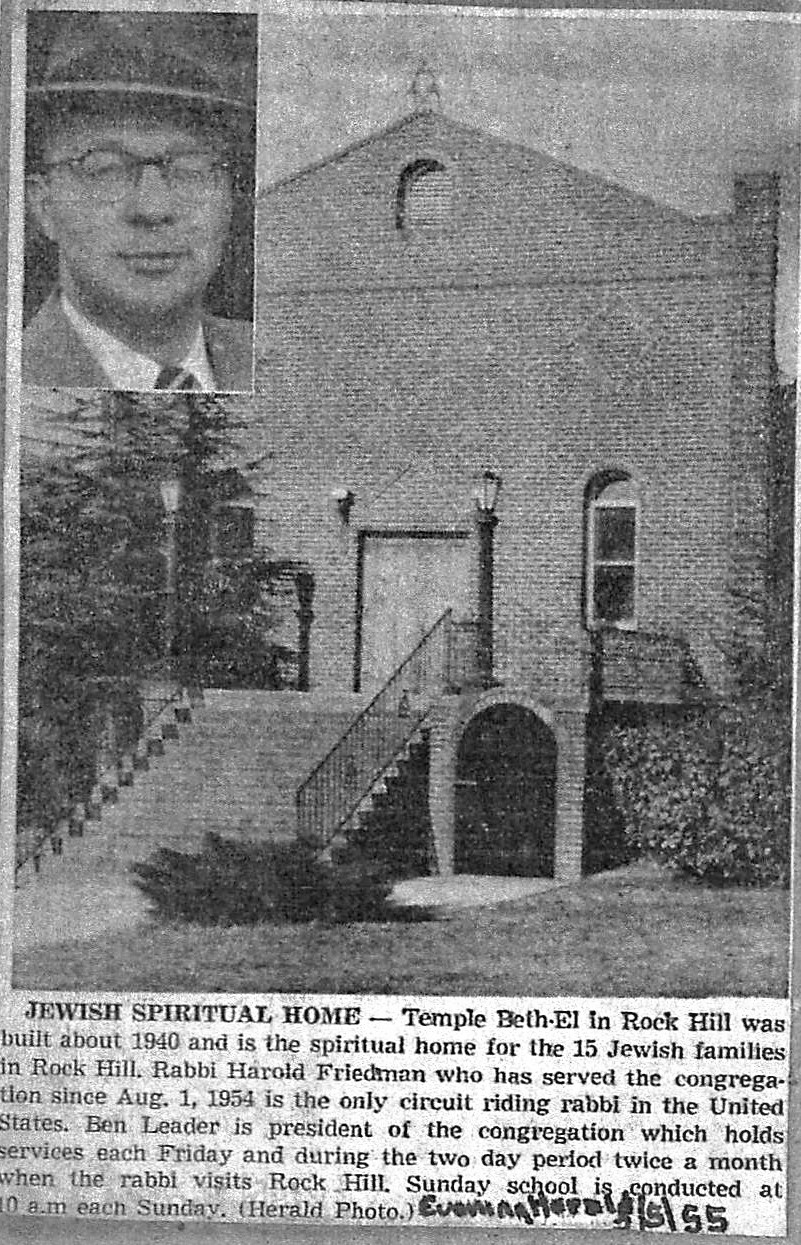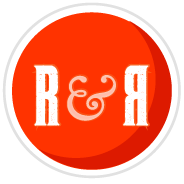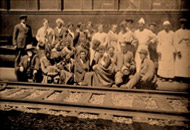City Directories and History: The EL-BETHEL SYNAGOGUE on West Main Street in Rock Hill, S.C. Article researched and written for R&R.com, by contributor, Mr. Paul M. Gettys – 11.12.21
Many current residents of Rock Hill might be surprised to learn that there was an active synagogue at 950 West Main Street for a number of years. Actually, people of the Jewish faith have been present since the early years of the village of Rock Hill, and have been an important part of the city’s culture and business community. Although we don’t normally think of South Carolina as a place of great religious diversity, from its beginnings as a colony in 1670, it had
one of the most tolerant policies for religious freedom in North America. Most colonies had strict limits on the faith of immigrants. The original governing statement of Carolina, the Fundamental Constitution, allowed anyone who believed in God, including Jews, to immigrate to South Carolina. Even though this liberal policy was changed later, Jews were an established part of the population in Charleston from the beginning. In fact, during colonial times and even as late as 1820, Charleston had the largest Jewish population of any North American city. The Beth Elohim Synagogue, established in 1749, is one of the oldest in the country. While the number of Jews in early South Carolina was never large as a percentage of the population, they were an important part of the culture of the colony. 1
Following the Civil War, the little village of Rock Hill in the Piedmont began to receive new residents from many backgrounds. Among them were Friedheim brothers, Jews with a German background, the first of whom arrived in 1866. They founded a department store that remained as one of Rock Hill’s premiere mercantile establishments for 100 years. 2 Other Jewish merchants came to Rock Hill in the late 1800s. This was a trend throughout the South, as Jewish immigrants, moving out from the cities of the northeast, found small towns where they could settle and make a good living as merchants. Hundreds of southern towns had a “Jew Store,” many of which became important to the local economy. Many of these families faced a dilemma, as did those in Rock Hill. How do you maintain your Jewish faith and culture when you are isolated as one family among a sea of Protestant Christians? How do you face the threat of violence from the Ku Klux Klan and other hate groups? Some Jewish families solved this problem by assimilating into the culture, joining the Presbyterian Church, and becoming part of the local power structure. Others attempted to hold on to their faith and culture, perhaps seeking out Jewish families in neighboring towns or travelling some distance to a larger city where there was a synagogue for services on the High Holy days and special occasions. 3
Because Charlotte was relatively close, Jews in Rock Hill had the opportunity to participate in the larger Jewish community there. By the late 1930s, however, a group of families began working toward a place to worship in Rock Hill. In 1939, a Hebrew Men’s Club was organized for the men of eighteen Jewish families in Rock Hill. The men involved in this group were: Nathan Arculis, M. Baker, Herman Baruch, Harold Dresner, H. Frohman, M. Frank, MacGoodman, A. L. Kurtz, Ben F. Kurtz, Ben Leader, K. Rosoff, S. Springer, J. Samet, A. R. Suritz, Morris Segal, Sam Troutman, and I. Ward. 4
Sol Aberman, perhaps the pre-eminent leader of the Jewish population in Rock Hill, was developing a section of land along the north side of West Main Street with a partner, J. Ruben Anderson. His wife, Bessie Aberman, purchased a part of this property from the partners for the purpose of providing a site for a synagogue. In April, 1940, Mrs. Aberman gifted the property to an entity named the Rock Hill Jewish Congregation. This generic name indicates that there was not yet a formal organization. 5 In February, 1940, the Rock Hill Chapter of Hadassah was organized with Mrs. Ben Kurtz as president. Hadassah is a national service organization for Jewish women. The group met for organization at the home of Mrs. W. J. Samet. Their major goal was to support refugee children overseas and to assist with local civic work. 6 This group has been described as one of the smallest Hadassah groups in the state, but one which often provided the highest levels of support for the work of the organization. It started with only four members, Mrs. Ben Kurtz, Mrs. Mac Goodman, Mrs. Ben Leader, and Mrs. Sidney Springer. The small size presented a dilemma.
The Hadassah rules stated that a minimum of 15 members was required to begin a chapter. Not to be outdone, the four ladies paid dues for 15 members and were duly chartered. 7 By 1952, their number had increased to 17, so they were finally legal. Just a year after the group was organized, in February 1941, Mrs. Kurtz attended the regional convention of Hassada in Savannah, Georgia as a representative of the local group. The group had a party at Confederate Park in Rock Hill prior to her departure to raise funds for Jewish refugees in Palestine. Local businesses donated prizes for the event. 8
By September, 1941, the Jews of Rock Hill began meeting as a group. They had begun construction of a synagogue on the West Main Street lot, but it was not ready for occupancy. Services, reported to be the first High Holy days observances ever marked in Rock Hill, were held at the newly constructed Municipal Stadium auditorium. This site was just behind the site for the new synagogue. Rabbi Schueffle of New York City was in charge of the services. About
100 persons attended, including a number of Jewish soldiers who were in the area participating in war games. “Members of the Jewish faith said as for as they knew these were the first organized Jewish religious High Holiday services ever held in Rock Hill.” Services followed the next week in observance of Yom Kippur, held at the armory on Saluda Street. 9 When the High Holy Days came in 1942, the group had its new home and services were able to be housed in Temple Beth El. Services began on September 11 and continued through the weekend. Rabbi Dave Tylsner (Telsner) of New York City was in Rock Hill for the Rosh Hashana services and remained until the Yom Kippur services. He was a guest in the home of Mr. and Mrs. Ben Leader on Eden Terrace. Because the local group never had a full-time Rabbi, it relied on visiting Rabbis and seminary students from New York and other Jewish centers of
learning to undertake the formal services. 10
In the early 1950s, the scattered groups of Jews in small towns in the Carolinas undertook a unique experiment to serving the small congregations. Under the leadership of I. D. Blumenthal, an industrialist and Jewish leader in Charlotte, a Rabbi was hired to travel among the scattered groups. Rabbi Harold Friedman was secured for this position about 1952. He developed a circuit which involved traveling 1,200 miles to far-flung communities in North Carolina and to Rock Hill in South Carolina. Soon, with financial support from the Charlotte synagogues, a bus was bought and outfitted with a library, a classroom, and necessary items for conducting worship. His bus visited towns such as Statesville, Huntersville, Albemarle, Jacksonville, Whiteville, Roanoke Rapids, Hickory, and Lumberton as well as Rock Hill. The local press dubbed him the “Circuit Riding Rabbi” and there were articles about this unusual ministry in a number of newspapers in the Carolinas. 11 Soon, the story went national. A photo spread appeared in Life Magazine 12 and there was a feature on Walt Disney’s Mickey Mouse Club News. 13 In July 1955, while continuing the circuit riding ministry, Rabbi Friedman and his wife Miriam Ramon Friedman moved to Rock Hill and rented a house at 619 North Avenue. By living here, they were able to spend more time with the congregation of Beth El. 14 After about two years, the Friedmans moved to Sarasota, Florida and later to Mobile, Alabama, where he had a long period of service.
Judy Kurtz Goldman, daughter of Mr. and Mrs. Ben Kurtz, has reflected on her years growing up in Rock Hill in the 1940s and 1950s. In interviews and memoirs, she discusses how her family, while observant and important members of Beth El, also sought to serve as liaisons with the larger community. Her mother invited non-Jews to attend special events at the Temple to introduce them to the faith and to help build ties to the community. She remembers services on Friday nights in the fall during the Jewish holy season when high school football games were occurring in Municipal Stadium, just behind the synagogue. She could hear the roars of the crowd, where all her friends were enjoying each other, while she was in religious services. She has fond memories of the community, its closeness and the beauty of the services and rituals. 15 As the 1960s began, the Beth El community was dwindling in size. Few new Jewish families were coming to Rock Hill to replace the older members who were passing away. The improved transportation to Charlotte meant that Jews in Rock Hill could more easily participate in the growing Jewish synagogues there. About 1963, Temple Beth El was closed. Later, the building was sold to the Church of Jesus Christ of Latter Day Saints (Mormons). They had begun a mission among the Catawba Indians at the nearby reservation, and had also started a group in Rock Hill. It later housed the West Side Church of God and now houses the Adams Chapel African Methodist Episcopal (AME) Church.
1 A summary of the early Jewish presence in South Carolina can be found in South Carolina: A History by Walter Edgar, University of South Carolina Press, 1998, pages 60 and 61.
2 The Louise Pettus Archives and Special Collections of Winthrop University in Rock Hill contains a document “The Friedheim’s of Rock Hill, South Carolina,” by C. H. Albright and Harper S. Gault which describes the family and its impact on Rock Hill.
3 An interesting book documenting one family’s story is The Jew Store: A Family Memoir by Stella Suberman (Algonquin Books of Chapel Hill, N. C. 2001). This describes her family’s story in Concordia, Tennessee. Judy Kurtz Goldman, a Rock Hill native, wrote a fictional book entitled The Slow Way Back. Her main character grew up Jewish in Rock Hill. Although not an autobiographical account, Judy relies on some of her memories of her childhood.
4 Rock Hill Herald, May 3, 1952.
5 York County Tax Assessor records.
6 Rock Hill Herald, March 29, 1940.
7 Rock Hill Herald, May 3, 1952.
8 Rock Hill Herald, February 6, 1941.
9 Rock Hill Herald, September 24, 1941 has an extensive article on the services.
10 Rock Hill Herald, September 11, 1942.
11 Typical articles were carried in The Charlotte Observer, March 23, 1955 and the Rock Hill Herald, September 24,
1953.
12 Life Magazine, September 19, 1955.
13 The Greenville News, October 30, 1955.
14 Rock Hill Herald, July 13, 1955.
15 Judy Kurtz Goldman submitted a short memoir to the rededication service of the El Bethel memorial plaque at
the Williams-Ivory Center in Rock Hill on August 16, 2021. In her novel, The Slow Way Back, her main character
has many memories of the local synagogue.
Stay Connected
Explore history, houses, and stories across S.C. Your membership provides you with updates on regional topics, information on historic research, preservation, and monthly feature articles. But remember R&R wants to hear from you and assist in preserving your own family genealogy and memorabilia.
Visit the Southern Queries – Forum to receive assistance in answering questions, discuss genealogy, and enjoy exploring preservation topics with other members. Also listed are several history and genealogical researchers for hire.
User comments welcome — post at the bottom of this page.
Please enjoy this structure and all those listed in Roots and Recall. But remember each is private property. So view them from a distance or from a public area such as the sidewalk or public road.
Do you have information to share and preserve? Family, school, church, or other older photos and stories are welcome. Send them digitally through the “Share Your Story” link, so they too might be posted on Roots and Recall.
Thanks!
User comments always welcome - please post at the bottom of this page.




Share Your Comments & Feedback: